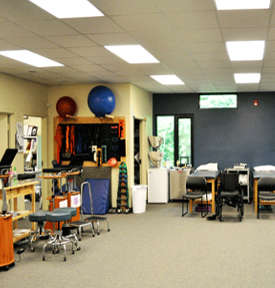
Functional training is a means of training your body as it would naturally perform a particular sport or task. Traditional strengthening and flexibility techniques don’t always render the stability and mobility required for functional movements. To better prepare your body, reduce injury and improve athletic performance, you must understand the biomechanics involved in the specific activity you plan to perform.
Our bodies were marvelously created to work together in synergy, with each part working together in order to perform movement. The body is a kinetic chain with each joint, muscle and connective tissue doing its part so the chain can function appropriately. Gravity and ground reaction forces are constantly affecting our movements. Forces are being dissipated up and down our kinetic chain with each joint absorbing and transferring the force to the next joint. When each of the links in the chain are working to their potential, the body moves like a well-oiled machine. However, when there is a disruption to the kinetic chain and one or more of the segments are not working correctly, the harmony is disrupted, with pain, dysfunction or injury as a result.
There are many different muscles that attach to the pelvis and spine as well as to the hips. If we take a look at just one of them, the hamstring muscle, it inserts into ischial tuberosity of our pelvis (bone you sit on) and then into back of the femur (upper leg bone) as well as the inside and outside portions of the tibia (lower leg bone). This hamstring muscle works in all three planes of motion to control and accelerate movement. Think of it as the reins on a horse with how it connects to both sides of the tibia. Most people do not understand how to stretch the hamstring in all three planes of motions. Simply understanding this can improve sports performance as well as reducing possible low back or hip pain.
The human body is uniquely designed to move in complex motions. Whether it is a routine task like reaching up into a cabinet or a more involved movement like heavy lifting or a sports activity, each of these tasks combine multiple joints and multiple planes of motion to accomplish the job.
The planes of motion are defined as the sagittal plane (moving forward and back), frontal plane (dividing the body into front and back) and transverse plane (dividing the body into top and bottom halves). The sagittal plane is the primary plane we function in – walking, running, biking and lifting all primarily involve this plane. Motion in the frontal plane occurs when our hips, legs or arms move toward or away from our midline, and is the least frequently utilized plane. Twisting and rotational movements happen in the transverse plane. Although we primarily utilize the sagittal plane of motion, our bodies utilize combinations of all three planes of movement thousands of time throughout the day.
A common injury seen in athletics are ACL tears. Research has shown that as many as 75 percent of ACL tears occur through what are classified as “non-contact injuries.” So, why does this happen? A major contributing factor is losing the ability to move or stabilize a part of the kinetic chain in any one of the three planes of motion. This can result in the development of compensatory movements, thus increasing the risk of injury. When compensatory movement patterns develop, your body is unable to move in its most mechanically efficient manner. This can lead to tissue breakdown and eventual injury.
It is important to detect the dysfunction, but more important to identify the underlying cause for the dysfunction in order to prevent re-occurrence or other injuries. At Integrated Rehabilitation Services, our therapists are specially trained in biomechanics and functional movement patterns, thus making training and rehabilitation more rapid and more effective. With functional strength training in all three planes of movement, we can improve the body’s adaptability and resiliency for directional changes with the goal of decreasing the potential for future injury.

